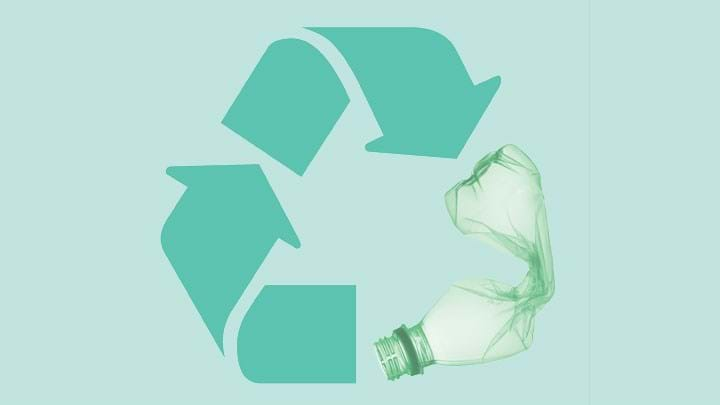Plastic Recycling: A Crosslinking Approach for Managing Mixed Waste

Amanda Jasi talks to Eugene Chen, Sanat Kumar, and Tomislav Rovis about the crosslinking solution they are developing to produce higher-value products from recycled mixed plastic waste
RECYCLING is widely regarded as the ultimate solution to the plastics problem, allowing the material to remain in use and preventing further resource extraction, while eliminating the need to employ potentially detrimental disposal routes. But this isn’t necessarily the case.
Looking at plastic packaging, a 2016 report from the Ellen MacArthur Foundation says that only 14% of plastic is collected for recycling, and after factoring in value losses due to sorting expenses and degradation in processing, only 5% of the material value is retained.
One challenge preventing more effective recycling is mixed plastic waste, an obstacle for typical recycling processes as different plastics tend to be immiscible and when recycled together result in poor-quality products.
Yet, “nearly all postconsumer plastics exist in mixed-waste streams,” said researchers from a team which has published a paper in Nature outlining how the crosslinking additives they have developed could help to overcome this issue. Members of the team told The Chemical Engineer that waste mixtures of plastic can consist of unsorted products made from different plastics, or can be within individual products such as a water bottle where the cap and bottle are made from different plastics, or a milk jug which combines layers of different plastics with different functionalities.
Lead researchers in the work Eugene Chen, Sanat Kumar, and Tomislav Rovis also spoke about how their dynamic crosslinking approach could allow higher-quality products to be recovered from typically employed mechanical recycling.
Made to come apart
Earlier this year, a collaboration involving BASF, Krones, Südpack, and Tomra announced a proof-of-concept project for closed-loop recycling of multilayer packaging made of polyethylene terephthalate (PET) and polyethylene (PE). The group’s work involved making films using a “debonding adhesive” developed by BASF to join the different functional materials. These were later separated in a standard hot-washing process used in PET recycling, allowing the separated PET and PE to be reused as monomaterials. In trials at a Krones pilot plant in Flensburg, Germany, the partners completely separated as much as 69% of packaging, and partially separated a further 12%.

Adding a little fairy dust
Mechanical recycling involves shredding plastic waste and then melting and resolidifying it into homogenous plastic pellets that can be reused. It typically results in downgraded plastics that have to be turned into lower-value products.
“Adding [a] little fairy dust” to this well-understood process, allows reprocessed mixed plastic to retain and even gain beneficial properties explained Kumar, professor of chemical engineering at Columbia University, US. The fairy dust is universal dynamic crosslinkers (UDCs) synthesised by Rovis, a professor of chemistry at the same university. During extrusion – a process which melts, mixes, and pelletises recovered plastic for reuse – the UDCs crosslink the polymers and make them compatibilised.
Rovis said that typically “if you put two different plastics through the extruder, they make a new material, but that material is basically islands of one plastic in a sea of the other plastic. It’s brittle, there’s no real structure to it, and there’s no tensile strength. You can put it into a stress test, and it fails miserably.”
However, adding 5% of one of the research group’s UDCs prevents this. Rovis said that when different plastics and a UDC are put through extrusion together, they all melt and at the temperature of melt a diazirene functional group at the ends of the UDC breaks apart. The three-membered diazirene ring, which contains two nitrogens and a carbon, becomes dinitrogen and a carbene, a very reactive carbon that only has two substituents. A carbene will insert into many types of bonds, including functional C–H bonds. This allows the UDC to covalently link one polymer chain to another, which might be the same polymer or a different one.
But he said the best part is a separate, exchangeable functional group in the middle of the UDC – different in each UDC – that allows for further points of connection so that the different chains can interweave and become functionally miscible.
Rovis noted that not every individual polymer needs to be crosslinked for success; “you just need the interfaces to be heavily crosslinked”.
In experiments, the research team was able to successfully create new materials that were a blend of polyethylenes (low-molecular-weight polyethylene, LMWPE, low-density polyethylene, LDPE, or high-density polyethylene, HDPE), and incompatible, bio-based polyesters (poly(L-lactic acid), PLLA, or poly(3-hydroxybutyrate), P3HB). They were even able to create a compatibilised blend of more than two plastics, using LDPE, PLLA, and isotactic polypropylene (iPP).
The researchers said the new materials are reflective of the input plastics, and the process even adds favourable characteristics such as reduced creep, which is the tendency of a solid material to deform permanently when under constant stress.
They also found that the new blends could be reprocessed, and when new polymer material was added in reprocessing this resulted in a new blend with a different composition.
Moreover, the team showed their method’s real-world applicability and tolerance for additions such as dyes and other additives, by using a UDC to successfully blend together a non-polar polyolefin LDPE bag and a polar bio-based PLLA cup, “which are notorious for their incompatibility,” said Chen, who is a professor of chemistry at Colorado State University, US. He said they have distinctly different and complementary properties such as the LDPE’s increased flexibility and decreased moisture permeability, compared to the harder and less-oxygen permeable PLLA. He also said that for certain applications, such as coatings or adhesives, incorporating polar components to non-polar polyolefins is required to enhance adhesion to polar surfaces.
While the researchers’ approach shows potential, the work is still at laboratory scale and there is further exploration needed around plastic compatibility and further reprocessing.
Kumar said that the team’s ability to understand how to design UDCs also needs to be developed, and they need to understand the mechanism by which they work. He said that there are still science questions, optimisation questions, and processing questions to answer.
Rovis said the group need to secure more funding to continue the work.
“We’re doing this, but we’re doing this slowly, and we need to do it quickly.”.
Pulling out polyurethane
Teijin Frontier, a textile and material manufacturer, is developing a method to remove polyurethane (PU) elastomer fibre from discarded polyester apparel to facilitate polyester recycling. The company said that stretchable polyester clothing containing PU elastomer is becoming popular due to demand for quick-drying, wrinkle-resistant, and comfortable-to-wear casual clothes. However, the PU acts as a contaminant that hinders polyester recycling.
It is developing technology that involves adding a novel processing agent during the pre-treatment phase of chemical recycling. In addition to removing the PU, the technology eliminates other foreign materials such as dyes which also degrade the quality of recycled products. Teijin declined to disclose process details but did say that it is continuing tests for practical use which began in October 2022.

Many plastics, many technologies
If realised, the team says its technology could help to manage the world’s plastic problem, but warned against going “all in” on any one solution.
Kumar said the paradigm must shift so that people see that investing in various solutions will help, adding that “[the] idea that people need to think broadly about a very broad problem needs to be put out there”.
“We’re going to need as many technologies as there are plastics, almost. It can’t be just one thing that’s going to solve this problem.”
Recent Editions
Catch up on the latest news, views and jobs from The Chemical Engineer. Below are the four latest issues. View a wider selection of the archive from within the Magazine section of this site.




